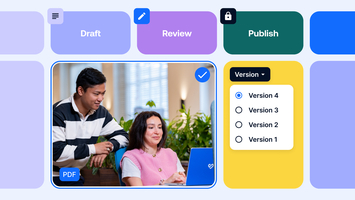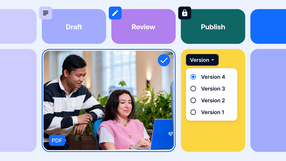This blog sets out the main differences between digital asset management (DAM) and a content management system (CMS), and how, when integrated, they can complement each other allowing brands to remain competitive, maintain brand consistency, and provide their customers with the very best content experiences.
DAM is software that allows marketers and creatives to easily and securely store, organize, and manage digital assets like images, creative files, 3D files, video, audio, and more. It’s a vital piece of technology for any brand that works with large volumes of digital assets, and it’s mainly utilized by marketers, designers, sales teams, third parties like digital agencies and brand partners.
A CMS is software that enables organizations to build, manage, and distribute its digital content for multiple channels, for example, a website. It allows them to create and publish content without the need for technical expertise or a deep knowledge of programming languages. Usually, a CMS is used by marketers, copywriters, content managers, SEO strategists, and web developers.
Now let’s take a quick look at how a DAM and a CMS differ from each other.
Digital asset management vs content management: What’s the difference?
DAM | CMS | |
What is it? | A centralized repository where a brand’s digital assets can be stored; providing a system of record.
| A user-friendly interface for creating and editing content, as well as tools for organizing, categorizing, and searching for content. |
Key features
|
And more… |
|
Main benefits |
|
|
What are the benefits of integrating DAM and CMS systems?
As we briefly touched on above, it’s not a case of DAM vs CMS. In fact, there are multiple strategic, creative, and operational benefits on offer when the two technologies are combined through integration.
Strategic benefits:
- Improved brand consistency: Only approved, on-brand assets are used.
System of record for all assets: Centralized media assets which improves consistency and reduces error across all digital channels. - Readiness for omnichannel: Enables the efficient, consistent deployment of assets across websites, apps, social media, and more.
- Enhanced levels of governance: Helps to enforce compliance and usage rights, especially critical for regulated organizations.
- Performance insights: Organizations can make more informed decisions when they can access performance and analytical data on asset use and content/campaign engagement.
Operational benefits:
- Smoother workflows: Assets can be accessed, uploaded, shared, updated, and published/distributed — all via one integrated system — meaning there’s no need for users to switch between different platforms.
- Taxonomy creation: This improves asset discoverability and search and helps power tasks like auto-tagging.
- More time for creativity: Fewer manual tasks, more asset reuse, and less duplicated effort means that marketers can claim more time back to be creative.
- Faster time to market: Creates efficiencies that allow users to save time and creative effort on creating variations and updating assets.
Creative benefits:
- Content creation and publishing at scale: Content from the DAM automatically powers the growing amount of content needed to build personalized content experiences.
- Increased confidence: Robust permissioning and version control mean that teams can only leverage the assets that are up-to-date and pre-approved for use.
- More collaborative working: Design, marketing, and content teams can work more efficiently due to shortened review cycles and fewer back-and-forth communications on requesting files or checking assets.
How do I integrate DAM and CMS?
Bynder currently offers 30+ CMS x Bynder integrations — including WordPress, Contentful, SiteCore, ContentStack, and Drupal. To achieve success with your DAM CMS integration you’ll need to conduct an audit to identify gaps in your current processes, choose a DAM that easily integrates with your chosen CMS, configure and then connect the DAM to the CMS so that your users can start accessing and utilizing digital assets directly from the CMS interface.

















